1970s
Circular Drive-in
In 1973, Lloyd Honey opened the Tricircle drive-in movie theater. It was the first-ever circular drive-in. The advantage of this was that it allowed x-rated movies to be shown, because the picture couldn't be seen from surrounding areas. This circular design was marketed as "Visible X" technology, but it doesn't seem to have caught on.More info from Drive-In Theaters by Kerry Segrave:
According to drive-ins.com, the Tricircle was torn down at some point, and there's now a Wal-Mart on the site.


Boxoffice magazine - Oct 20, 1975
Posted By: Alex - Fri May 27, 2016 -
Comments (9)
Category: Movies, 1970s
Stealing Boosts Staff Morale
Companies do all kinds of things to boost staff morale. They hire motivational speakers, have team-building exercises, give employees gifts, etc.But the industrial psychologist Lawrence Zeitlin, in an article published in June 1971 in Psychology Today ("A little larceny can do a lot for employee morale"), argued that the most effective way a business could boost morale was by allowing its employees to steal a little from the company.
He argued that theft added to a sense of "job enrichment" by making the job more interesting. It gave employees a sense of satisfaction at getting away with it. Also, workers "often looked upon theft as a condition of employment." Furthermore, he noted, allowing the theft could be cheaper than installing elaborate security precautions.
In her book Management and Ideology, business author Judith Merkle provides some background info on Zeitlin's article:
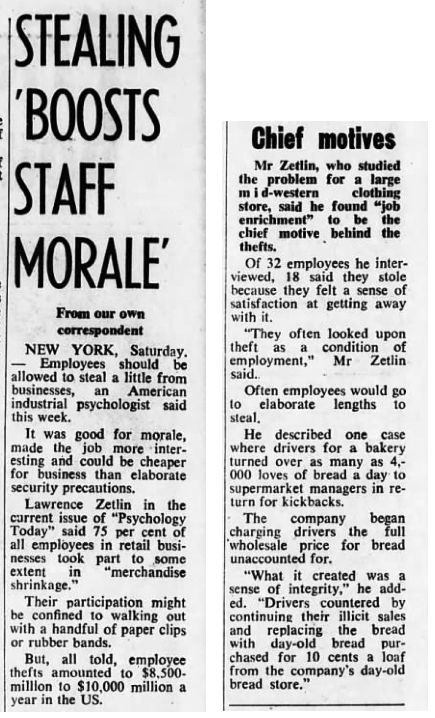
Sydney Morning Herald - May 30, 1971
Posted By: Alex - Wed May 25, 2016 -
Comments (6)
Category: Business, Crime, 1970s
Pre-Game Frog Head Biting
1977: Larry Canaday, football coach at Eau Gallie High School in Florida, would inspire his players to victory by biting the head off a live frog. No one at the school was particularly disturbed by this. Parents would even give him frogs before games to help fire up the kids. But when word of the unusual motivational technique began to attract national attention, school officials told Canaday that the "frog-biting must cease."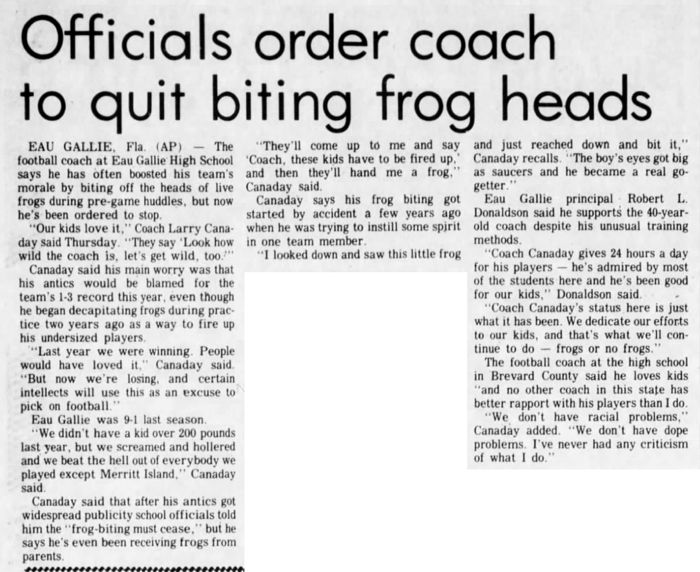
The Bloomington Pantagraph - Oct 14, 1977
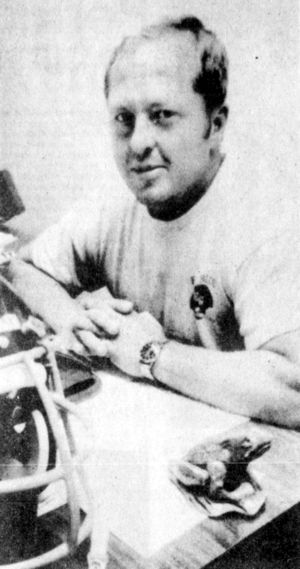
Coach Canaday, with frog statue
Posted By: Alex - Mon May 23, 2016 -
Comments (6)
Category: Rituals and Superstitions, Sports, 1970s
Suit Against Satan
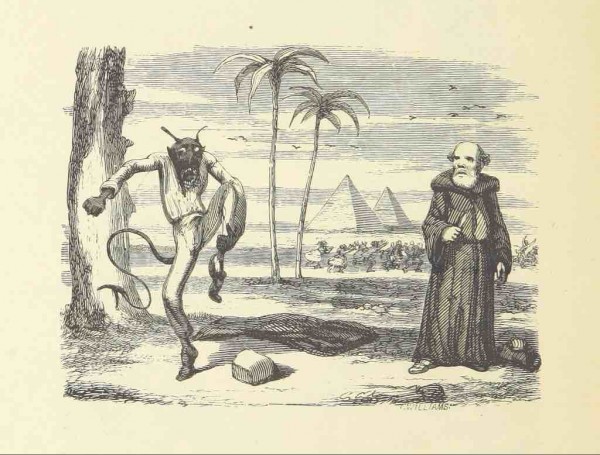
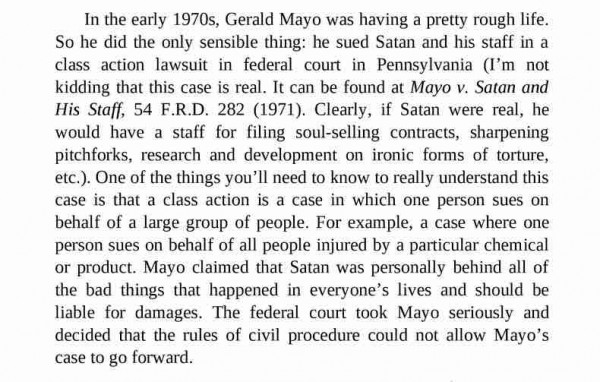
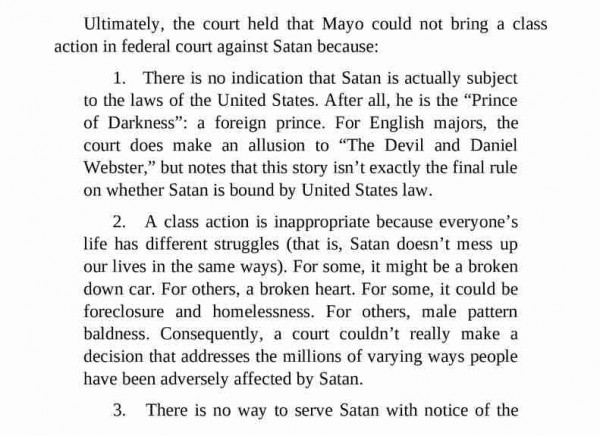

Original text here.
Wikipedia entry here.
Posted By: Paul - Thu May 19, 2016 -
Comments (7)
Category: Really Bad Ideas, Religion, Stupidity, Superstition, Lawsuits, 1970s, Fictional Monsters
Elderly Should Lose Vote
Back in 1970, Douglas P. Stewart, a professor of classics at Brandeis University, made headlines for advocating that the elderly should lose the right to vote."The old, having no future, are dangerously free from the consequences of their own political acts, and it makes no sense to allow the vote to someone who is actuarially unlikely to survive and pay the bills for (what) he may help elect."
In other words, Stewart thinks old people vote with an attitude of "grand je serais mort, je me ficherais de tou — (when I'm dead, it (society) can go to hell)."
Stewart, if he's still alive, would now be around 83. I wonder if he's still voting?

The Daily Journal (Franklin, Indiana) — Sep 23, 1970
Posted By: Alex - Tue May 17, 2016 -
Comments (12)
Category: Elderly and Seniors, Politics, Elderly, 1970s
The Case of the Confused Tourist
October 1977: German tourist Erwin Kreuz took a flight from Augsburg to San Francisco. When it landed in the United States, he got off.Three days later, he realized he wasn't actually in San Francisco. Instead, he was in Bangor, Maine, where the plane had stopped for refueling. Kreuz realized his mistake when he got bored of wandering around what he thought were the suburbs of San Francisco, got in a cab, and asked to go to downtown San Francisco. The cabbie somehow managed to inform him (despite Kreuz's total lack of English) that it would be a very long trip.
Kreuz later explained that when he had been sitting on the flight, after it had landed, a stewardess had walked past him and wished him a "pleasant stay in San Francisco." The crew was being switched during the refueling, so she was just saying goodbye, but Kreuz assumed it meant they had arrived in SF. So he deboarded, went through customs, and managed to get a cab to a local hotel.
When the media got word of Kreuz's mix-up, he became a national celebrity. The SF Examiner flew him out to San Francisco at their expense, where he got to meet the mayor and tour the city.
A year later Kreuz returned to Bangor to be the celebrity guest at the opening of a shopping mall, but things for him then went downhill because the brewery where he worked back in Germany fired him for taking too much time off.
In 1979, Kreuz returned to Bangor a third time, hoping to find a job by cashing in on his celebrity. But the only job he was offered was as a janitor. So he returned to Germany.
More info: Wikipedia, Bangor Daily News

The La Crosse Tribune - Oct 29, 1977

Erwin Kreuz
Posted By: Alex - Mon May 16, 2016 -
Comments (4)
Category: Tourists and Tourism, 1970s
Johnny Horizon
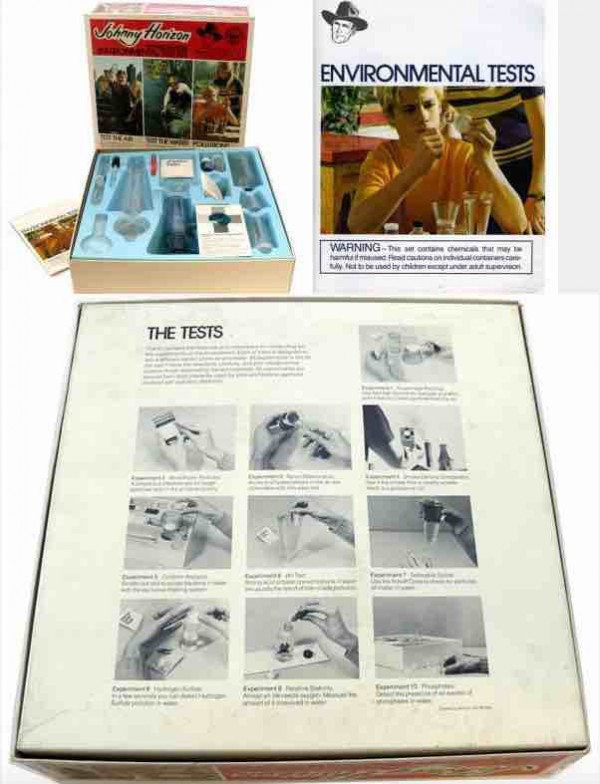
"Mom, Dad--I want to grow up to be an EPA field-worker like Johnny Horizon!"
Such were the words probably never actually spoken in the early 1970s, when the icon of Johnny Horizon was launched by the BLM. But if any lad or lassie did utter such a wish, then they could have been placated with the Johnny Horizon Environmental Test Kit. Parker Brothers showed a little poindexter hard at work in their ads for the kit.

Original ad here.
Posted By: Paul - Sun May 15, 2016 -
Comments (5)
Category: Geeks, Nerds and Pointdexters, Government, Nature, Toys, 1970s
L.A. 2017
Just a year away from seeing if Steven Spielberg nailed his predictions from 1971, the year he made this show, L.A. 2017. Seeing elderly hippes still performing some fifty years after the Summer of Love, and knowing the Rolling Stones still go on tours, I think Spielberg might have been on to something!
Posted By: Paul - Fri May 13, 2016 -
Comments (7)
Category: Television, Science Fiction, Bohemians, Beatniks, Hippies and Slackers, 1970s
Mystery Illustration 19

What product was this extremely funky individual advertising?
The answer is here.
Posted By: Paul - Sun May 01, 2016 -
Comments (5)
Category: Advertising, 1970s
Cable Car Nymphomaniac
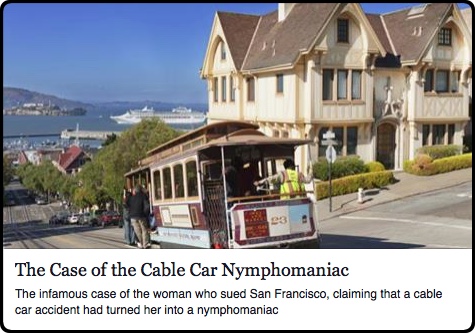
In 1964, a San Francisco cable car rolled partway down a hill before it came to an abrupt stop, causing a passenger, Gloria Sykes, to bang her head against a pole. Six years later, Sykes sued the railway, claiming that the accident had caused her to develop an "insatiable and uncontrollable desire for promiscuous sex." In other words, she had become a nymphomaniac.
The lawsuit is remembered to this day as one of the most bizarre cases in San Francisco's history. Here we take a closer look at it.
The Accident
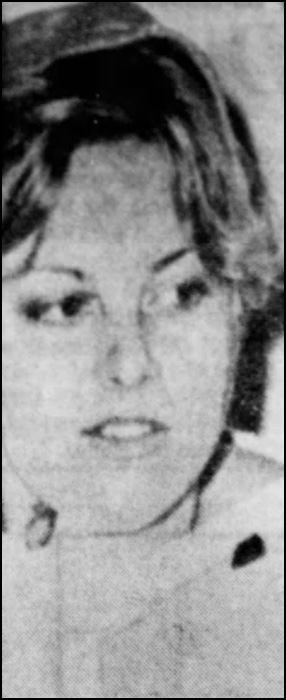
Gloria Sykes
The accident happened on September 29, 1964. Skyes was onboard a cable car, near the rear exit, as it climbed the steep Hyde Street incline, away from Fisherman's Wharf. About three-quarters of the way up the hill the cable grip suddenly failed, and the car started to slide backwards.
Thirty-six people were onboard. Sixteen of these managed to jump off the car as soon as they realized something was wrong. That left twenty people, including Sykes.
As the car rolled downhill, it quickly picked up speed, going faster and faster. Sykes screamed out, "Don't panic!"
The car rolled for almost three blocks before the gripman yanked on the emergency brake, causing the vehicle to come to an abrupt, shuddering halt. Passengers went sprawling onto the floor and slammed into seats. Sykes banged her head into a steel pole which, she later told a reporter, "I put a dent in."
Luckily, everyone survived in one piece, although many were banged up a bit. Sykes walked away with two black eyes and many bruises, but otherwise she seemed okay. However, "seemed" was the key word. Although the physical injuries soon healed, the emotional trauma did not go away as easily.
Sues For Damages
The next year, Sykes filed a lawsuit against the municipal railway, asking for $36,000 in damages on account of her injuries. However, her lawsuit got tied up in the legal system and remained unsettled.
So five years later, in 1970, Sykes filed a new suit (Gloria Sykes v. San Francisco Municipal Railway), and now she demanded much greater compensation, $500,000. Through her new lawyer, Marvin E. Lewis, she also introduced the dramatic claim that the accident had transformed her into a sex-addict.
The case, with its irresistible mix of an attractive woman and hypersexuality, immediately grabbed the attention of the media. Headline writers seemed to compete to come up with bad puns to describe it, such as "Sex Transit Gloria" and "A Streetcar-Blamed Desire."
Headline-Grabbing Details
During jury selection, Lewis summarized the case for the prospective jurors, telling them he would present evidence to prove that the 1964 accident had irrevocably changed Sykes's life. Sensational details from this summary soon made national news.
Before the accident, as Lewis told it, Sykes had been a deeply religious, strait-laced young woman — a Sunday school teacher and choir girl — but the accident had radically altered her, causing her to develop an "insatiable appetite for sex."
Lewis described how Sykes chose partners at random "when the vibrations were right." Her desire could be sparked by the "mere meeting of eyes while passing on a street." In the past year alone she had slept with over one hundred men, and recently her cravings for physical contact had begun to extend to other women.
However, said Lewis, these cravings had not been a source of pleasure for her. Instead, it had turned her life into a nightmare. Once trim-figured, she had gained over 20 pounds. She had contracted venereal disease (since cured), had had an abortion, and had even attempted suicide.
In addition, she had become a hypochondriac, imagining heart, lung, kidney, and back problems. All these problems made it difficult for her to keep a steady job.
According to Lewis, Sykes was a miserable woman, and all her miseries had started with the 1964 accident caused by the negligence of the railway.
Choosing The Jury
The lawsuit, in addition to sparking a media frenzy, represented a legal first. There had been previous cases where people had sued because an accident had caused a loss of sexual appetite (impotence or frigidity), but no one had ever sued because of increased sexual desire.
Lewis carefully screened the potential jurors to make sure that none of them had a problem with this central premise of the suit. He asked each one, "Could you believe a cable car accident could make a nymphomaniac of a proper, if attractive young woman?"
As it turned out, only one prospective juror indicated that this seemed implausible, and Lewis promptly dismissed her.
Eventually a full jury was selected, eight women and four men, and the trial was ready to proceed.
The Plaintiff's Case
The trial got underway in early April, 1970. It was presided over by Superior Court Judge Francis McCarty.
In making the case for why Skyes deserved $500,000 in damages, Lewis pursued two lines of argument. First, he brought in character witnesses — friends and acquaintances of Sykes — who testified about the change in her personality before and after the accident. Second, he used expert psychiatric testimony to try to persuade the jury about the reality and seriousness of Sykes's psychological condition.
One of the first to testify was a long-time female friend of Sykes who described how before the accident Sykes had been a "religious, upright girl," but afterwards had begun to have one affair after another.
The friend noted that she had once asked Sykes how she managed to meet so many men, and Sykes had responded that "it was easy. You just go up and talk."
The friend also revealed that Sykes had kept a diary, detailing all her sexual encounters. Despite this diary, Sykes often couldn't remember the last names "and sometimes even the first names" of her partners.
The existence of a tell-all sex diary immediately attracted the interest of the media. Lewis noted that he had received many offers from news organizations eager to print excerpts from it. However, the judge ruled that it had to be kept from the media until the end of the trial. (And it apparently never was published.)
As for the medical testimony, the jury heard from psychiatrists such as Drs. Andrew Watson and Meyer Zeligs, both of whom had concluded that Sykes was "getting no pleasure out of her numerous sexual relationships." Instead, they said, her promiscuity was the result of a search for security.
Lewis concluded by emphasizing to the jury his belief that Sykes suffered from a medical condition caused by the 1964 accident. She had, he said, "a neurosis that is no different from cancer or any other serious disease."
The Defense Responds
Deputy City Attorney William Taylor represented the municipal railway. From the start, he repeatedly dismissed as "unbelievable" the idea that a cable car accident could turn a woman into a nymphomaniac.
To undermine Sykes's case, he made three arguments.
First, he suggested that her nymphomania was caused not by the accident, but rather by birth control pills that she had started taking in 1965. The use of birth control pills, Taylor declared, could cause "promiscuity and unnatural sex drives."
Second, Taylor noted that Sykes had sexual affairs before the accident. Lewis conceded this was true, but insisted that "the episodes were few and were 'affairs of the heart.'"
Finally, Taylor brought in psychiatrist Dr. Knox Finley who testified that Sykes could have developed nymphomania without ever having been in an accident. Finley suggested that in Sykes's mind the accident had become a symbol on which she blamed every difficulty in her life.
Testimony of Sykes
During most of the trial, Sykes herself made no appearance. Lewis said that doctors had advised her that daily attendance would be too stressful.
But three weeks into the trial, towards the end, she finally showed up, took the stand, and testified for two-and-a-half days to a standing-room-only crowd.
Her testimony was surprisingly ambivalent. In response to a question from her lawyer about whether she thought the 1964 crash had given her an irrepressible sex urge, she said, "Mr. Lewis, I find it very difficult to believe that there's a connection between my cable car feelings and this sex urge. I don't know exactly what did it — a lot of things... that all worked together."
This mirrored pre-trial statements Sykes had made to reporters in which she expressed uneasiness about the nymphomania label. For instance, she had said, "I am not a nymphomaniac. After all I've been through I just needed a lot of affection, reassurance and security. And most men are not affectionate unless you become involved with them."
She had also said, "I feel so bad about this whole thing. I know how this must be hurting my family. But this emphasis on sex is all wrong."
These comments suggest that the legal strategy of focusing on her supposed "nymphomania" may primarily have been Lewis's idea, and Sykes only reluctantly weny along with it.
The Verdict
Before the jury left to deliberate, the judge issued a surprise directed verdict declaring that Sykes had suffered "some" injury as a result of negligence. Therefore, the only question left for the jury to decide was how much compensation she should receive. Lewis repeated the demand of $500,000, while Taylor suggested that a far lower number of $4500 would be reasonable.
The jury left the courtroom and came back with their answer eight hours later. Sykes, they said, would receive $50,000.
Headlines trumpeted the news: "Jury Rules Runaway Cable Car Caused Runaway Sex," "Sex-Starved Patient Gets $50,000."
But while it was true that Sykes had received an award, what the headlines failed to convey was that the size of the award was far less than what she had sought. Only one-tenth of it. And most of the award would have to go to legal fees, leaving Sykes with close to nothing.
In this sense, the verdict was not a victory for Sykes. The relatively small size of the award indicated that the jury must have been skeptical about the link between the cable car accident and Sykes's crowded sex life.
The defense attorney said he was "not unhappy" about the verdict.
Lewis tried to spin the outcome as positively as he could. He claimed the decision represented a "legal breakthrough" that established the principle of "psychic damages." But he simultaneously admitted he was disappointed with the amount of the award and said he might appeal. That never happened.
Aftermath
After the trial ended, the case no longer made front-page headlines, but interest in it endured. Throughout the 1970s, numerous references to the case continued to appear in news articles. Journalists often referred to it as the "cable car named desire" case.
There were two main reasons for the fascination with the case. First, it seemed to capture so much of the cultural tension surrounding the "sexual revolution" of the 1960s and 70s. Here was a modest, midwestern girl who moved to San Francisco and got swept up in a new, more hedonistic lifestyle, which ultimately proved too much for her. The case seemed to be as much about the sexual revolution, and the ongoing clash of cultures in America, as it was about a cable car accident.
Second, the case fed into concerns about an increase in frivolous lawsuits. Critics of American legal culture used it as a favorite example, summarizing it as the case of the woman who sued San Francisco claiming a cable car accident had turned her into a nymphomaniac — and won! This was true, but overlooked the fact that she won far less than she had sought. And the damages were for her injuries in general, not nymphomania specifically.
What happened to those involved in the case?
The lawyer, Marvin Lewis, continued to make headlines by specializing in unusual cases that often had a sexual theme. For instance, in 1973 he represented another once-devout woman turned sex-hungry nymphomaniac. His client, Maria Parson, sued a health club for $1 million, claiming that the experience of being locked inside a sauna room had caused her to develop multiple personalities, one of which was highly promiscuous. However, a jury declined to award her any damages.
Sykes dropped out of public view. A search of multiple news archives provides no information about what she did with her life after the trial.
However, interest in her story has continued to the present. So much so that in 2014 it achieved one of the highest honors a weird news story can earn. It got turned into a musical. The production, titled The Cable Car Nymphomaniac, debuted to positive reviews at San Francisco's Fogg Theatre.
Posted By: Alex - Fri Apr 29, 2016 -
Comments (8)
Category: Lawsuits, 1970s

| Who We Are |
|---|
| Alex Boese Alex is the creator and curator of the Museum of Hoaxes. He's also the author of various weird, non-fiction, science-themed books such as Elephants on Acid and Psychedelic Apes. Paul Di Filippo Paul has been paid to put weird ideas into fictional form for over thirty years, in his career as a noted science fiction writer. He has recently begun blogging on many curious topics with three fellow writers at The Inferior 4+1. Contact Us |




